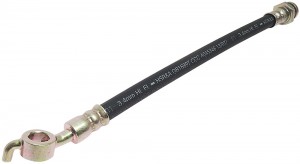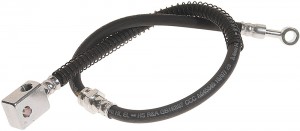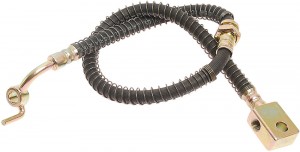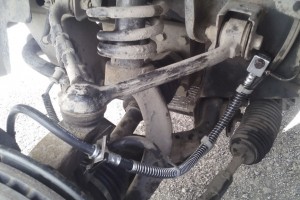South Korean SSANGYONG cars are equipped with a hydraulically operated braking system that uses brake hoses. Read all about SSANGYONG brake hoses, their types, design features and applicability, as well as the selection and replacement of these parts in this article.
Purpose of SSANGYONG Brake Hose
The SSANGYONG brake hose is a component of the brake system of cars of the South Korean company SSANGYONG; Specialized flexible pipelines that circulate the working fluid between the components of the hydraulically driven brake system.
SSANGYONG cars of all classes and models are equipped with traditional brake systems with hydraulic wheel brakes. Structurally, the system consists of a brake master cylinder, metal pipelines connected to it, and rubber hoses going to the wheels or to the rear axle. In cars with ABS, there is also a system of sensors and actuators, which are controlled by a separate controller.
Brake hoses occupy an important place in the brake system - the controllability and safety of the entire car depends on their condition. With active use, the hoses wear out intensively and receive various damages, which can impair the operation of the brakes or completely disable one circuit of the system. An exhausted or damaged hose must be replaced, but before going to the store, you should understand the features of the brake hoses of SSANGYONG cars.
Types, characteristics and applicability of SSANGYONG brake hoses
The brake hoses used on SSANGYONG vehicles differ in purpose, types of fittings and some design features.
According to the purpose, hoses are:
● Front left and right;
● Rear left and right;
● Rear central.
On most SSANGYONG models, only four hoses are used - one for each wheel. In models Korando, Musso and some others there is a rear central hose (common to the rear axle).
Also, hoses are divided into two groups according to their purpose:
● For cars with ABS;
● For cars without ABS.
Hoses for brake systems with and without anti-lock braking system differ structurally, in most cases they are not interchangeable - all this should be taken into account when choosing spare parts for repair.
Structurally, all SSANGYONG brake hoses consist of the following parts:
● Rubber hose - as a rule, a multilayer rubber hose of small diameter with a textile (thread) frame;
● Connecting tips - fittings on both sides;
● Reinforcement (on some hoses) - a steel coiled spring that protects the hose from damage;
● Steel insert in the middle of the hose for mounting on the bracket (on some hoses).
There are four types of fittings used on SSANGYONG brake hoses:
● The type of "banjo" (ring) is straight short;
● Type "banjo" (ring) elongated and L-shaped;
● Straight fitting with internal thread;
● Square fitting with female thread and mounting hole.
In this case, there are two options for hose fittings:
● "Banjo" - a straight fitting with a thread;
● "Banjo" is a square.

SSANGYONG Unreinforced Brake Hose

SSANGYONG Partial Reinforcement Brake Hose

SSANGYONG reinforced brake hose with insert
The banjo fitting is always located on the side of the wheel brake mechanism. The fitting of the "square" type is always located on the side of the connection to the metal pipeline from the master brake cylinder. A straight fitting with an internal thread can be located both on the side of the wheel and on the side of the pipeline.
As mentioned above, brake hoses can have reinforcement, according to the presence of this part, products are divided into three types:
● Unreinforced - only short front hoses of some models;
● Partially reinforced - reinforcement is present on the part of the hose located on the side of the connection to the metal pipeline;
● Fully reinforced - the spring is located along the entire length of the hose from fitting to fitting.
Also, a steel insert (sleeve) can be located on long-length hoses for fastening in a bracket located on the steering knuckle, shock absorber strut or other suspension part. Such a mount prevents damage to the hose from contact with suspension parts and other elements of the car. Mounting on the bracket can be done in two ways - with a bolt with a nut or a spring plate.
On early and current models of SSANGYONG cars, a wide range of brake hoses is used, differing in design, length, fittings and some characteristics. It makes no sense to describe them here, all information can be found in the original catalogs.
How to choose and replace the SSANGYONG brake hose
Brake hoses are constantly exposed to negative environmental factors, oils, water, vibrations, as well as the abrasive effect of sand and stones flying out from under the wheels - all this leads to a loss of strength of the part and can cause damage to the hose (cracking and tearing). The need to replace the hose is indicated by cracks and brake fluid leaks visible on it - they give themselves out as dark spots and dirt on the hose, and in the most difficult cases - puddles under the car during prolonged parking. Damage that is not detected in a timely manner and that is not replaced can turn into a tragedy in the very near future.
For replacement, you should take hoses only of those types and catalog numbers that are installed on the car by the manufacturer. All original hoses have 10-digit catalog numbers starting with the numbers 4871/4872/4873/4874. As a rule, the fewer zeros after the first four digits, the more suitable hoses are for newer car modifications, but there are exceptions. At the same time, the catalog numbers for left and right hoses, as well as parts for systems with and without ABS, may differ by only one digit, and different hoses are not interchangeable (due to different lengths, specific location of fittings and other design features), so the choice of spare parts should be approached responsibly.
Replacement of brake hoses must be carried out in accordance with the repair and maintenance instructions for a particular model of SSANGYONG car. As a rule, to replace the front and rear left and right hoses, it is enough to lift the car on a jack, remove the wheel, dismantle the old hose and install a new one (not forgetting to clean the fittings connection points first). When installing a new hose, you need to carefully tighten the fittings and securely fasten the part to the bracket (if provided), otherwise the hose will be in free contact with the surrounding parts and will quickly become unusable. After replacement, it is necessary to bleed the brake system to remove air locks according to a well-known technique. When replacing the hose and pumping the system, brake fluid always leaks, so after completing all the work, it is necessary to bring the fluid level to the nominal level.
Replacing the rear central hose does not require jacking up the car, it is more convenient to do this work on an overpass or above a pit.
If the SSANGYONG brake hose is selected and replaced correctly, the vehicle's braking system will work reliably and confidently in all operating conditions.
Post time: Jul-10-2023

 SSANGYONG brake hose: a strong link in the brakes of the "Koreans"
SSANGYONG brake hose: a strong link in the brakes of the "Koreans"